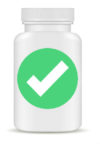Table of Contents
Vanadyl Sulfate – Supplement Profile
Vanadyl sulfate (VS) is a form of the element vanadium. Vanadium exists in at least six different states with VS being only one of them. While no “essential” biological function discovered for vanadium. This doesn’t mean it doesn’t have biological effects, it simply means that it is not considered an essential nutritional element.
Vanadium used for treating prediabetes and diabetes. Also, low blood sugar, high cholesterol, heart disease, tuberculosis, syphilis, a form of “tired blood” (anemia), and water retention (edema). Also improving athletic performance in weight training; and for preventing cancer.
How does it work?
There is evidence that vanadium acts like insulin, and acts to increase the effects of insulin on muscle.
Vanadyl acts as a phosphatase inhibitor (1). Like insulin, VS promotes the phosphorylation of tyrosyl residues in the insulin receptor. The first step in initiating the cascade of events normally seen when insulin binds to it (2). This happens even without insulin. In the presence of insulin however, VS will extend the duration that the insulin receptor is active.
Recent research has even shown that VS can activate the insulin cascade by mechanisms besides interacting with the insulin tyrosine kinase receptor (3). These are the ways in which VS decreases blood glucose and increases glycogen synthase activity (i.e. glycogen storage). There is even some evidence that vanadium can stimulate insulin release from the pancreas (4). Keep in mind that these effects are not just happening in muscle cells, but also in fat cells.
Keto Diet and VS
So why use VS if it isn’t anabolic? Well, with the popularity of ketogenic diets incorporating a carb loading phase, the value of an insulin mimicker becomes obvious. Often people advocating ketogenic diets forget to tell you that going into ketosis significantly reduces insulin sensitivity. During ketosis this has the effect of decreasing glycogen usage and increasing fatty acid usage. Unfortunately during the reloading phase this leads to decreased glucose uptake leaving you feeling flat and weak. The only way to correct the problem is to increase insulin levels, decrease fatty acid levels, or better yet, both.
By adding VS, whey isolate, and a little nicotinic acid (w/B6) to your initial carb drinks you can do both without messing with injectable insulin and thereby significantly increase glucose uptake during the brief reloading phase. If you do this properly you will notice a significant increase in weight (mostly water) and a satisfying feeling of fullness in the muscle bellies.
More Research on VS
Recent research is now focused on making VS more effective. Several forms of vanadium are indeed more effective and research continues today to finally arrive at a form that is well tolerated, potent, and that can compete on some level with existing antidiabetic drugs. So far several forms of vanadium have been found to be significantly more potent and less toxic than VS (5).
Bis(maltolato)oxovanadium (BMOV) is your best bet if you want to use vanadium today. It is significantly more potent than VS and is also significantly less toxic. VS has been shown to interfere with growth of young rats whereas BMOV shows no such effects while producing superior insulin-like effects (6). Perhaps the top dog of vanadium insulin mimickers not yet available is vanadyl acetylacetonate. It has shown to be even more potent than bis(maltolato)oxovanadium. Other researchers are now trying to explore the possibility of transdermal vanadium and are showing some early success (7).
References:
- Stankiewicz PJ., Gresser MJ. Inhibition of phosphatase and sulfatase by transition-state analogues. Biochemistry 27:206-212, 1988
- Tamura S., Brown TA., Whipple JH., et al: A novel mechanism for the insulin-like effects of vanadate on glycogen synthase in rat adipocytes. J Biol Chem. 259:6650-6658, 1984
- Pandey SK, Anand-Srivastava MB, Srivastava AK. Vanadyl sulfate-stimulated glycogen synthesis associated with activation of phosphatidylinositol 3-kinase and independent of insulin receptor tyrosine phosphorylation. Biochemistry 12;37(19):7006-14, 1998
